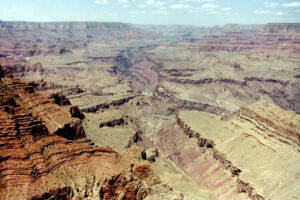In the last two issues of the Happ-0-getics I began this as a four-part series. (See the June and August 2023 issues for the evidence from the inspired Word of God and from the fossils.)
The third argument is: A global flood is supported by the evidence in the rock layers.
I am a biological scientist, not a geologist. I am persuaded by those who are, however, that there are good reasons to conclude that the sedimentary rock layers were deposited rapidly by a cataclysm such as the biblical global flood. Briefly, I will identify four.

Presence of rock layers across continents
It would take an incredible force to deposit a world-wide series of layers. For example, the Tapeats Sandstone consists of beds of sand extending across the entire U.S., North Africa, and the Middle East. The Coconino Sandstone layer near the top of the Grand Canyon is on average 315 feet thick and covers an area of about 930,000 square miles extending from Mexico to Canada. The volume of sand in this layer is about 55,000 cubic miles.
Features within sedimentary rock layers
Huge boulders are found in the layers that could have been deposited only by huge storms such as the catastrophic flood. Also, there are sloped sand beds (cross-beds) within some rock layers that can only be deposited by rapidly flowing water with powerful currents.
No time gap between rock layers
The evolutionary time scale maintains that it took millions of years for the sedimentary layers to accumulate. If so, the boundaries between the strata should show weathered surfaces from millions of years of erosion. We don’t find that but rather evidence of only rapid erosion with flat and featureless boundaries. This is consistent with rapidly deposited strata without long periods of elapsed time.
Presence of folded rock layers
The Kaibab Plateau in the Grand Canyon is 4,500 feet above sea level except the eastern portion which is about 2,000 feet. At some time in the past the higher section was pushed up to create a 90 degree fold (a right angle) where the two parts connect. The rock at the fold should be broken since it would already be hard if it was deposited over millions of years. But it isn’t cracked. The likely explanation is that the rock layers were deposited rapidly and within months uplifted while they were still soft and pliable (like modeling clay).
Conclusion: Only a catastrophic global flood can adequately explain these observations.
Source: Answers Magazine, “Global Evidences of the Genesis Flood,” July-Sept. 2021, pp. 44-52.



